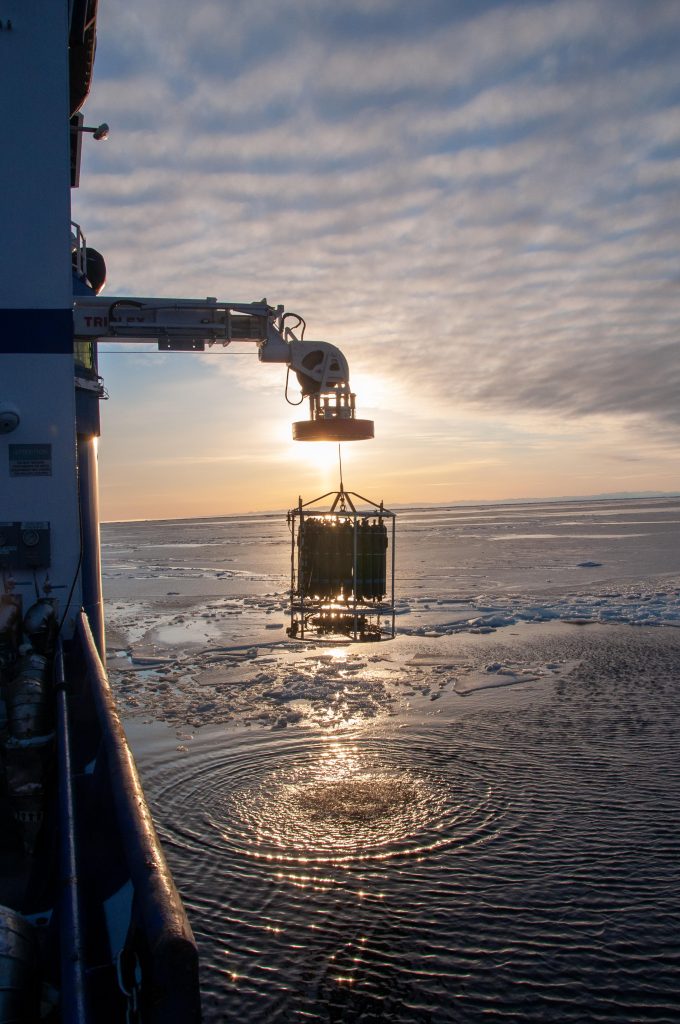
Collecting measurements at the ice edge, the western Arctic Ocean. Credit: Peigen Lin/Woods Hole Oceanographic Institution
A recent study has presented the initial observational proof of the stabilization of the anti-cyclonic Beaufort Gyre, which is the dominant circulation in the Canada Basin and the largest store of fresh water in the Arctic Ocean.
The research utilizes a recently prolonged record of “dynamic ocean topography” satellite information from 2011 to 2019, which was supplied by two of the co-authors, in combination with a comprehensive hydrographic data set from 2003 to 2019, to measure the evolution of the sea surface height of the gyre in recent years.
Previous observations and modeling that relied on earlier dynamic ocean topography data up to 2014 have documented that the gyre has strengthened and increased its freshwater content by 40% compared with 1970s climatology. Stabilization of the gyre could be a precursor of a huge freshwater release, which could have significant ramifications including impacting the Atlantic Meridional Overturning Circulation (AMOC), a key component of global climate.
The Beaufort Gyre “has transitioned to a quasi-stable state in which the increase in sea surface height of the gyre has slowed and the freshwater content has plateaued. In addition, the cold halocline layer, which isolates the warm/salty Atlantic water at depth, has thinned significantly due to less input of cold and salty water stemming from the Pacific Ocean and the Chukchi Sea shelf, together with greater entrainment of lighter water from the eastern Beaufort Sea. This recent transition of the Beaufort Gyre is associated with a southeastward shift in its location as a result of variation in the regional wind forcing,” according to the recent study which was published in Nature Geoscience.
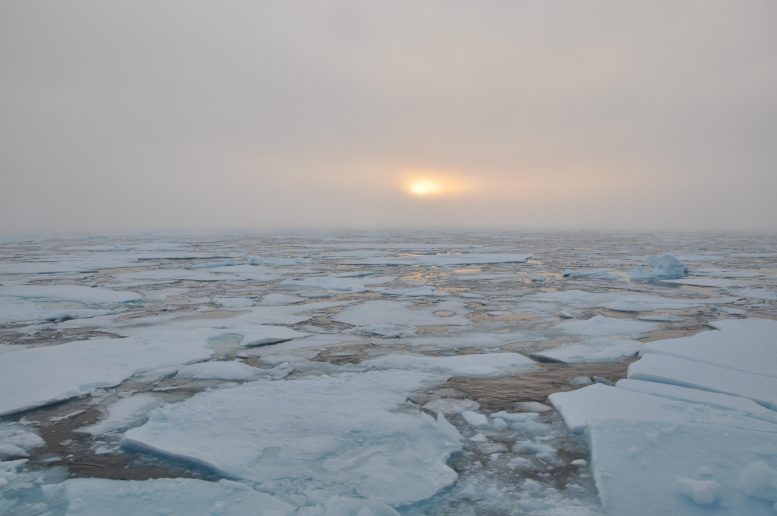
Sunrise at the ice horizon in the western Arctic Ocean. Credit: Peigen Lin/Woods Hole Oceanographic Institution
“Our results imply that continued thinning of the cold halocline layer could modulate the present stable state, allowing for a freshwater release,” the article states. “This in turn could freshen the subpolar North Atlantic, impacting the AMOC.”
Because there could be many potential local and remote impacts of the changing gyre on the hydrographic structure, physical processes, and ecosystem of the Arctic, “it is of high interest to better understand the factors associated with such changes—including the underlying causes,” the article notes.
“People should be aware that changes in the circulation of the Arctic Ocean could threaten the climate. It’s not only the melting ice and animals losing their habitat that should be a concern,” said Peigen Lin, lead author of the paper. Lin, who is an associate professor at the Shanghai Jiao Tong University’s School of Oceanography in China, conducted his research as a postdoctoral investigator at the Woods Hole Oceanographic Institution (WHOI) in Massachusetts.
With the gyre being the Arctic Ocean’s largest freshwater reservoir, “if that freshwater gets released and ends up spreading into the North Atlantic, it could impact the overturning circulation, and, in an extreme case, disrupt it,” said co-author Robert Pickart, a senior scientist in WHOI’s Department of Physical Oceanography.
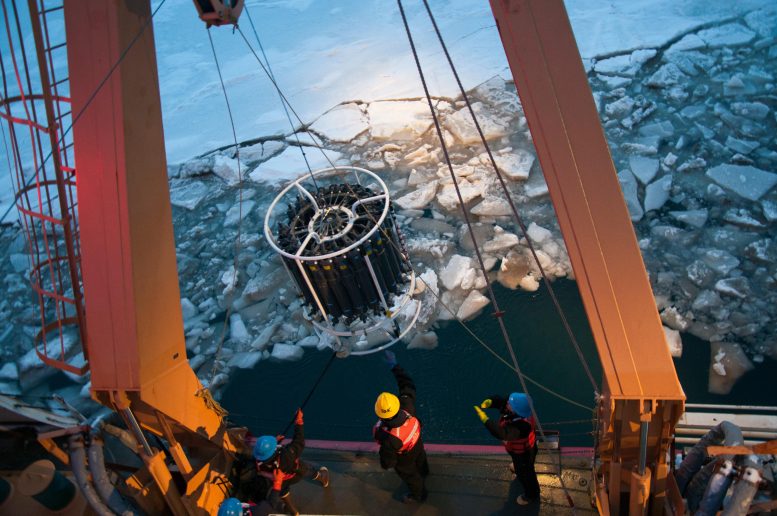
Collecting measurements in the ice, the western Arctic Ocean. Credit: Peigen Lin/Woods Hole Oceanographic Institution
The study, which includes an examination of long-term trends of the Beaufort Gyre and the causes of the thinning of the cold halocline layer, quantifies the evolution of the gyre in terms of its sea surface height as well as its freshwater content. “Both of these indicate that the Beaufort Gyre has stabilized in the second decade of this century,” Lin said.
The study also addresses the causes of the halocline thinning considerably as the gyre has evolved. The study notes that the recent decrease in the amount of Pacific origin winter water exiting the Chukchi Sea explains some of the thinning, and that the enhanced influence from the eastern Beaufort Sea – due to the gyre’s southeastward shift– likely also contributes to the thinning.
The recent documented state of the gyre “does not represent a return to the initial condition of 2003 when the gyre was weak and located partially in the southeastern basin. Instead, under the strengthened wind stress curl, the gyre has continuously intensified even though it has contracted, and it has maintained its excess freshwater storage,” the article notes.
Lin said a goal regarding the gyre is to understand the mechanisms behind its changes, which ultimately could allow scientists to predict what the gyre might do in the future.
“The community has been confounded by the fact that this gyre has kept growing and growing, and everyone is expecting it to release,” Pickart said. “Wouldn’t it be something if the gyre system and its freshwater accumulation and release could become somewhat predictable? Then, perhaps, we could also shed light on what a warming climate is going to do to this system.”
Reference: “Recent state transition of the Arctic Ocean’s Beaufort Gyre” by Peigen Lin, Robert S. Pickart, Harry Heorton, Michel Tsamados, Motoyo Itoh, and Takashi Kikuchi, 8 May 2023, Nature Geoscience.
DOI: 10.1038/s41561-023-01184-5
The study was funded by the National Science Foundation; the National Oceanic and Atmospheric Administration; the Shanghai Pujiang Program and Shanghai Frontiers Science Center of Polar Science; the European Space Agency Project and Natural Environment Research Council; the Arctic Challenge for Sustainability projects of the Ministry of Education, Culture, Sports, Science and Technology, Japan; and the Arctic Challenge for Sustainability II (ArCS II).
Co-authors Harry Heorton and Michel Tsamados of University College London provided the updated dynamic ocean topography data from 2011-2019 for the study. Co-authors Motoyo Itoh and Takashi Kikuchi of the Japan Agency for Marine-Earth Science and Technology (JAMSTEC) provided the mooring data regarding the Beaufort Gyre source water.

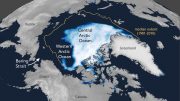


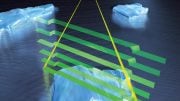




Be the first to comment on "First Evidence of the Beaufort Gyre’s Stabilization: A Precursor to a Freshwater Catastrophe?"